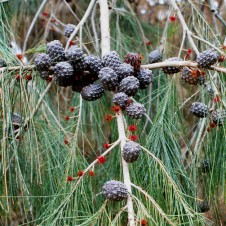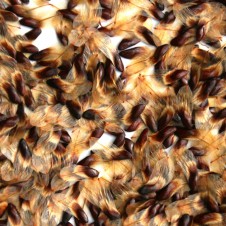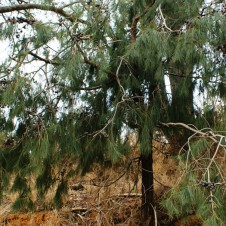General Description: An open, leafless small tree or large shrub with needles similar to a pine tree, 4 to12 m tall, with fine, curved, grey-green branchlets, and woody cones.
Flowers and Fruit: Males and females on separate plants. Males: a narrow spike, to 4 cm long, consisting of orange stamens emerging from branchlets. Females: a dense, red tuft of styles, about 1 cm wide (March to May). Fruit is a cylindrical, woody cone, to 30 x 20 mm, with numerous, beaked capsules, each containing winged seeds.
Site Preference and Tolerances: Prefers well drained hill and mountain slopes on sands, clays or rocky sites. It may also occur on lowland flats, rocky gorges, swamp margins, heathlands and on sandy lowlands behind sand dunes. Will grow on moderately alkaline and very poor soils, can produce large root nodules which house microorganisms that provide the tree with nitrogen.
Life Span: Medium (20 to 80 years).
Wildlife Value: Seed is eaten by parrots and finches.
Other Values and Uses: A useful tree for avenue plantings where larger trees are undesirable. It is popular in cultivation as an ornamental and its bark is considered excellent for growing orchids on. It is an excellent tree for relatively low, narrow shelterbelts and can be used to recolonise very poor sites. It is excellent firewood and aboriginal people used the wood to make implements, boomerangs and weapons.
Other Scientific Names: Casuarina leptoclada, Casuarina littoralis, Casuarina moesta, Casuarina suberosa
Other Common Names: Black Sheoke, Erect She-oak
Germination Information: Usually grows well in a few weeks without any treatment.



